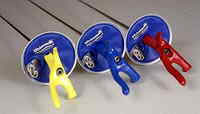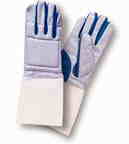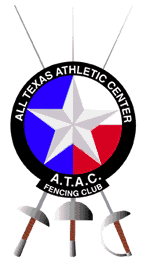What Does It Cost to Compete?
What Does It Cost to Compete?
Fencing is a relatively inexpensive sport, until you begin traveling to other states to compete at the national level, but there are initial costs to consider for even local tournaments.
USFA Membership
Membership in the United States Fencing Association is a requirement for anyone competing in local or national tournaments. Membership forms are always available at the club. Fees are $65 for competitive fencing.
|
|||
 |
Electric Weapons
Competing at the local or national level, a fencer must have at least two working weapons when they report to the strip. Electric weapons run from $65 to $150. For novice competitors, the less expensive weapons are just as good as the expensive ones. Many vendors offer an electric beginner set (blade, body cord, etc.) for around
|
||
$100-150. Electric epee sets are less expensive because there is no lamé; saber sets are a little more expensive. Women must add an additional $25 or so for a breast protector.
|
|||
Body Cords
A body cord connects the fencer's blade to the scoring equipment. In official competitions, two working body cords are required when a fencer reports to strip. The body cords are not interchangeable between foil and epee; you will need foil and epee body cords to compete with both weapons. Body cords are $15 - 35.
|
 |
||
Underarm Protector or Plastron
Every fencer must have an underarm protector (plastron) to compete. There is a wide variety of materials and quality involved with these, but you are looking for a piece of clothing that will cushion a blow to the soft armpit. Underarm protectors range from $16 to $100. Chest protectors for women are available at the club for use. Women must have protectors during competition. These are available as a solid plastic sheet or as protective discs that fit into pockets in the jacket, and range $8-30. Young boys may choose to wear a solid plastic chest protector when first learning. All men should wear athletic cups.
|
|||
Glove
Gloves come in a variety of material from cotton to the Uhlmann washable leather, and range $10-45. Look at some of the gloves the other competitive fencers wear and ask questions about their choice.
Lame
The lame is an outer conducting garment which defines the target
|
 |
||
area in foil and saber. Foil lames will run $40-135; saber lames, $85-255.
|
|||
 |
Mask
A good competition mask for foil and epee will run around $75. Three weapon masks, and the stronger FIE masks, will range from $95 to $275. It has been our experience that a little extra invested in a stronger test mask is worth it. Novice competitors may use ATAC masks.
Jacket
Jackets, $50-230.
Knickers
Knickers may be purchased for $50-230.
Shoes and Socks
The fencer's legs must be completely covered. Long soccer
|
||
socks, preferably white, under baseball pants or knickers are perfect ($10-15). Fencing shoes may be purchased for $45-190.00, Adidas high-tops being the most expensive. Any flat soled deck shoe (Keds) with a light or white flexible sole will work.
|
|||
Saber Manchet
This is a special conducting oversleeve required for saber fencers, $30-55, if a regulation saber glove is not used.
|
|||
 |
Fencing Bags
Used to carry weapons and equipment, bags run $25-300 for single weapon bags to wheeled bags.
Tournament Fees
Local fees average $25.00 per event (a tournament is comprised of several events). National tournaments can cost $50 and up per event.
|
||
Other costs for tournaments may include travel, meal and lodging expenses and coaches' fees. Coaches' fees are used to offset expenses incurred by the ATAC coaching staff when traveling as the team representative.
|
|||
